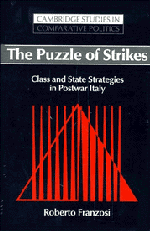Book contents
- Frontmatter
- Contents
- List of tables, figures, and equations
- Dedication
- Preface
- Acknowledgments
- 1 The puzzle box
- 2 Labor-market conditions and bargaining power
- 3 When do workers strike? How the economy matters
- 4 Organizational resources and collective action
- 5 The structure of collective bargaining
- 6 Class power, politics, and conflict
- 7 Mobilization processes: the 1969 autunno caldo
- 8 Countermobilization processes: reactions by the state and employers to strike waves
- 9 The picture in the puzzle
- Epilogue
- Appendix: the data
- Notes
- Bibliography
- Index
Preface
Published online by Cambridge University Press: 08 January 2010
- Frontmatter
- Contents
- List of tables, figures, and equations
- Dedication
- Preface
- Acknowledgments
- 1 The puzzle box
- 2 Labor-market conditions and bargaining power
- 3 When do workers strike? How the economy matters
- 4 Organizational resources and collective action
- 5 The structure of collective bargaining
- 6 Class power, politics, and conflict
- 7 Mobilization processes: the 1969 autunno caldo
- 8 Countermobilization processes: reactions by the state and employers to strike waves
- 9 The picture in the puzzle
- Epilogue
- Appendix: the data
- Notes
- Bibliography
- Index
Summary
We know more and more about less and less until at the end we know everything about nothing.
This book took four years to write and ten to rewrite (in an ideal sense, anyway, because the actual rewriting took place between April 1992 and September 1993, with further spells of writing between April and December 1994). It started as a dissertation project in the Department of Sociology (back then, Social Relations) at The Johns Hopkins University in 1978. carried out the empirical work and the final writing of the dissertation at the Centro Studi Confindustria in Rome, during the two years I spent there as a researcher, from September 1979 to August 1981. I began the rewriting during the 1981–82 academic year at the Center for Research on Social Organizations at the University of Michigan and continued it at the University of Wisconsin.
Several people back then thought the dissertation to be of sufficient quality to be publishable as a book (it was accepted as such in 1986 by another press). Over the years they encouraged me, pushed me, threatened me to “get it out.” Why, then, has it taken me ten years to do so? The answer to this question is bound up with both professional and personal strands of my life. In 1982, I believed that the dissertation was a good piece of statistical analysis. After all, I had taken great care in digging out long forgotten and buried data, in teasing out the statistical details of the arguments, in always being true to the data and what they had to tell me.
- Type
- Chapter
- Information
- The Puzzle of StrikesClass and State Strategies in Postwar Italy, pp. xvii - xxiiPublisher: Cambridge University PressPrint publication year: 1995

